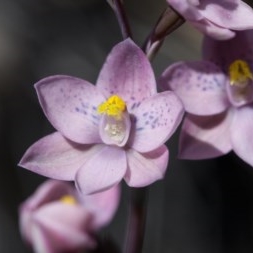Crested sun orchid facts for kids
Quick facts for kids Crested sun orchid |
|
|---|---|
 |
|
| Thelymitra x irregularis growing near Murrumbateman | |
| Scientific classification | |
| Genus: |
Thelymitra
|
| Species: |
irregularis
|
The Thelymitra irregularis, often called the crested sun orchid, is a special type of orchid. It grows only in southeastern Australia. This orchid has one long, dark green leaf. Its flowers are bright pink with darker spots. There can be up to eight flowers on one plant. Each flower has a yellow, bumpy crest on top of its anther, which is the part that holds pollen. This orchid is a natural hybrid (a mix) of two other orchid types: T. ixioides and either T. carnea or T. rubra.
Contents
What Does the Crested Sun Orchid Look Like?
The Crested Sun Orchid is a tuberous plant. This means it grows from a swollen underground stem, like a potato. It is also a perennial herb, so it lives for more than two years and has soft stems. It has one dark green leaf that is shaped like a line and tapers (gets narrower) at the end. This leaf is about 10 to 20 centimeters (4 to 8 inches) long and 3 to 4 millimeters (0.1 to 0.2 inches) wide.
Flowers and Stems
The plant produces a flowering stem that grows 20 to 40 centimeters (8 to 16 inches) tall. On this stem, you can find up to eight bright rose pink flowers. These flowers have darker spots and are about 20 to 25 millimeters (0.8 to 1 inch) wide. There are also one or two bracts (small, leaf-like parts) along the flowering stem.
Flower Parts
The sepals and petals of the flower are about 7 to 10 millimeters (0.3 to 0.4 inches) long. The column is a special part in the center of the orchid flower. It is pink with a dark band near the top and is about 6 to 7 millimeters (0.2 to 0.3 inches) long. The part on top of the anther has a yellow, bumpy, semi-circular crest. The side parts of the column have pale golden yellow, hair-like tufts at their ends. These orchids usually bloom from September to November.
How Was the Crested Sun Orchid Named?
The Crested Sun Orchid was first officially described in 1946. This description was made by a botanist named William Henry Nicholls. He found a sample of the orchid near a place called Wonthaggi. The description was then published in a science magazine called The Victorian Naturalist.
Meaning of the Name
The scientific name for this orchid is Thelymitra irregularis. The second part of the name, irregularis, is a specific epithet. This word was chosen because the middle part of the column in the flower has a "broken and very irregular toothed" shape.
Where Does the Crested Sun Orchid Grow?
The crested sun orchid grows in places where its two parent species are also found. You can find it in different types of environments, such as heathlands, woodlands, and open forests. It is found across southeastern New South Wales, southern and eastern Victoria, Tasmania, and South Australia. While it is spread out across these areas, it is not a very common orchid to find.

